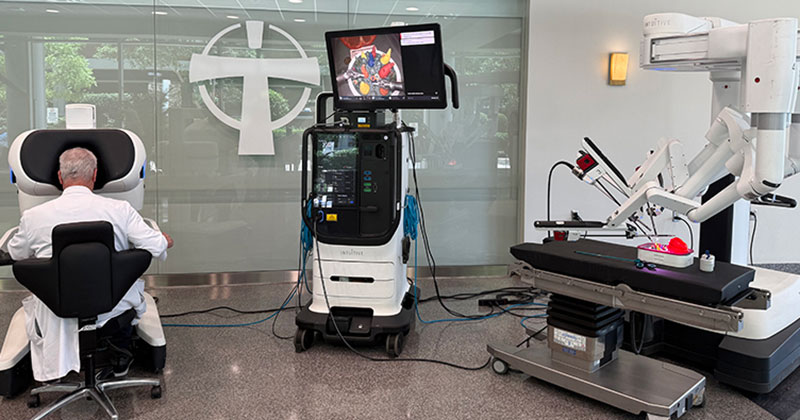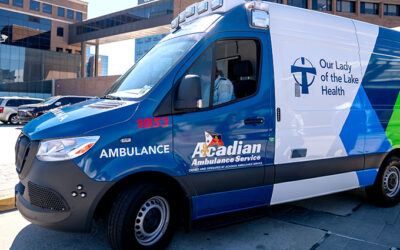Franciscan Missionaries of Our Lady Health System is ushering in a new era of surgery with the addition of nine da Vinci 5 robotic systems, the most advanced generation of surgical robots available today. Equipped with artificial intelligence, responsive touch and real-time collaboration tools, these machines represent a powerful leap forward in precision medicine and surgeon education.
It’s a powerful leap forward — one that blends cutting-edge technology with hands-on skill to deliver safer, faster and more precise surgeries. For surgeons across FMOLHS, the investment is about more than cutting-edge hardware. It’s about improving patient outcomes by revolutionizing how they operate, how they learn and how they support each other in real time.
“This is the most technically advanced hospital in the state right now,” says Daryl Marx, MD, FACS, general surgeon and medical director of Our Lady of the Lake Robotic Surgery Institute. “We have world-class surgeons using world-class technology. And when you get those two intersecting, you get world-class results.”
Precision You Can Feel
At the core of the da Vinci 5’s innovation is its ability to replicate a surgeon’s sense of touch. New force feedback technology lets the surgeon feel the amount of pressure being applied to tissue, something that wasn’t possible with earlier robotic models. This tactile sensation enhances both safety and control during delicate procedures, especially in minimally invasive surgery where physical contact with the tissue is limited.
“We could imagine tension visually before, but now we can actually feel it,” says Mark Hausmann, MD, FACS, FASMBS, general surgeon at Our Lady of the Lake. “That adds a layer of safety for the patient and another level of feedback for the surgeon.”
Increased precision means fewer complications, faster recovery times and a reduced likelihood of long-term issues like hernias or bowel obstructions. The technology allows more procedures to remain minimally invasive, avoiding the risks associated with traditional open surgery.
Learning as You Operate
What sets the da Vinci 5, or dV5, apart from earlier generations is its AI-powered learning system. The robot collects thousands of data points during each procedure, tracking everything from hand movements to how much pressure is placed on tissue. Over time, this data helps generate performance insights that allow surgeons to improve their technique in a measurable, personalized way.
“The machine learns what we’re doing,” Dr. Marx says. “It captures our hand motions, how much tension we’re putting on tissue, where we’re looking, and then it delivers a training module that helps us strengthen the skills we need to improve.”
Surgeons can access simulators built into the machines and train in real time between cases. That accessibility allows both seasoned surgeons and residents to continually refine their skills without leaving the operating room. What once required scheduling time in a simulation lab can now happen between surgeries, right at the console.
Dr. Hausmann sees even greater potential ahead: “As we add more data, it adds more opportunities for us to improve. The AI will eventually give us an independent assessment of our efficiencies and tissue handling.”
Collaboration Across the Health System
Another groundbreaking feature of the new system is the ability for surgeons to consult with colleagues across different hospitals during a live operation. Surgeons can share their console view with others anywhere in the FMOLHS network, allowing for real-time feedback, guidance and collaboration.
This functionality is especially important for an academic health system like FMOLHS, where experienced robotic surgeons often mentor younger physicians. “Now we can expand our influence in teaching far beyond the borders of just the OR,” says Phillip Allen, MD, chief of surgery and perioperative services at Our Lady of the Lake. “That’s hugely important for us.”
Dr. Marx noted that the system helps bridge the isolation new surgeons may feel during complex cases. “There’s no other job where you’re completely alone and can’t look something up,” he says. “Now we’re allowing other brains into the operating room with us, which inevitably is going to make us better.”
Scaled for Growth and Access
Three of the new robots have been installed at Our Lady of the Lake Regional Medical Center in Baton Rouge, with others placed at St. Dominic Hospital in Mississippi, St. Francis Medical Center in Monroe and Our Lady of Lourdes Regional Medical Center in Lafayette. The network-wide rollout ensures that patients throughout the region have access to the same level of advanced surgical care, no matter where they receive treatment.
The installation is also opening doors for new services. One of the replaced fourth-generation systems is being moved to Our Lady of the Lake Children’s Hospital, launching a pediatric robotic surgery program, one of the first in the country. Another is headed to Our Lady of the Lake St. Elizabeth in Gonzales to increase capacity and access to minimally invasive procedures.
“This is a huge growth opportunity in our ability to provide minimally invasive surgery across the state,” Marx says.
Platform Designed for the Future
With 10,000 times the computing power of previous models, the dV5 is built for ongoing evolution. Unlike earlier robotic systems, which eventually reached their technical limits, this platform is designed to grow with software updates and modular enhancements, making it more like a Tesla than a traditional surgical device.
“It still drives very similarly to the previous generation,” Marx says, “but now it has a heads-up display, better ergonomics and the ability to improve itself and us along the way.”
That forward-looking approach is exactly why FMOLHS made the investment. The health system has long been a leader in robotic surgery, and this latest addition ensures it stays at the forefront of surgical innovation.
“We’re fully committed to advancing robotic surgery and being a leader in this space,” Dr. Allen says. “This is the next step — being on the cutting edge and advancing the technology as quickly as we can.”




